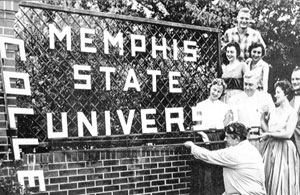
University of Memphis
Names reflect an institution’s history, and the University of Memphis has undergone several name changes: West Tennessee State Normal School (1912-25), West Tennessee State Teachers College (1925-30), State Teachers College, Memphis (1930-41), Memphis State College (1941-57), Memphis State University (1957-94), and The University of Memphis (1994-present). Whatever the name, its location in Memphis favored the college. A town oriented to a rural economy and culture in 1900 had become a large urban center by mid-century, and its public college expanded from a normal school to a comprehensive university.
Born during a rare moment of educational reform, the Normal’s first mission was to train teachers for West Tennessee elementary and high schools. Memphis obtained the school after a vigorous competition against other regional cities. Although the state-funded institution’s potential for the city was obvious, its origins were humble: three red brick buildings on an eighty-acre campus just outside the city. The initial enrollment reached three hundred students, many of whom required a high school diploma before obtaining a teacher certificate. By 1925, however, the school accepted only high school graduates and began granting bachelor’s degrees. As enrollment reached one thousand, the college set the tone for educational life throughout its area, producing excellent teachers and administrators for the rapidly expanding public school systems.
Early faculty and administrators, known as the “Schoolmen,” took on the aspect of “Founding Fathers.” Buildings bore their names, legends grew up about them, and former students looked back on their teaching careers with deep appreciation. The thirty or forty faculty members were dedicated to good teaching, service, and loyalty to the school. Few placed academic specialization before guiding students, who ate with faculty at the common dining hall, saw them gathered at regular chapel programs, and participated with them in extracurricular activities. Some early traditions such as the school colors, the tiger mascot, and an atmosphere of “democratic” informality have endured.
Until just after World War II, the college paralleled its peers under the State Board of Education. Identical budgets and programs prevented rivalry between institutions. A college’s destiny was related to state politics as filtered through the attitudes of governors, legislators, newspaper editors, and the governing board. Decisions made in Nashville prescribed admission policies, academic programs, and financing. Furthermore, prevailing opinion assumed that Tennessee could afford only one public university of quality.
Demographics, however significant, never determined the entire history of the college; personal leadership emerged during times of crisis to provide continuity and progress for the institution. President J. W. Brister led an old-fashioned “campaign” in the 1930s, when the Great Depression caused retrenchment and the annual budget dropped to thirty-five thousand dollars, almost forcing the college to close. President J. B. Sanders, a nationally respected historian, overcame a second low point during World War II, when the college lost accreditation and student enrollment plunged to two hundred. Sanders’s sterling character and the influx of veterans restored the college.
By the 1950s the college undertook a second mission by steadily expanding its offerings in liberal arts, business, and graduate work. After several futile attempts, university status was achieved in 1957. President J. M. Smith and the popular C. C. Humphreys convinced state officials and rival college supporters that metropolitan Memphis required a new mission for its college. Several factors helped bring this about: funding from other than state sources; active local support groups such as Greater Memphis State; successful NCAA basketball teams; the replacement of local clubs by national Greek and academic societies; and the operation of a large Air Force ROTC unit.
In the 1960s and 1970s, programs, facilities, faculty, and enrollment expanded rapidly. A large-scale building program and the acquisition of additional land transformed the campus. New programs were added in graduate education, law, engineering, continuing education, and nursing. Since the 1980s, as enrollment remained stable at approximately twenty thousand students, the university sought to raise standards to match its physical expansion and become a regionally recognized multipurpose university. Revised funding formulas factored academic excellence into the university’s third mission. Research grants and gifts became available; institutes and bureaus proliferated; and chairs and centers of excellence, including the Center for Earthquake Research and Information, enhanced research at the university.
Memphis and its university are inseparably linked, and African Americans comprise half the city’s population. From eight students in 1959 to two thousand by 1970, African American students helped fulfill the goal of a “democratic” opportunity for higher education. As the 1990s closed, the university had 26 percent black enrollment and was a national leader in minority-student graduation rates. Memphians have supported their university’s sports programs, providing local athletic talent such as Larry Finch and Anfernee (Penny) Hardaway, the Liberty Bowl Stadium for football, and the Pyramid for basketball. Indeed, this proud tradition in intercollegiate athletics has helped bridge racial divisions. In this and many other respects, the little school of 1912 has become a treasured asset.



